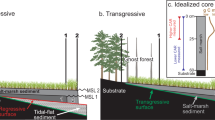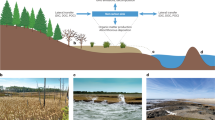Abstract
About half of annual marine carbon burial takes place in shallow water ecosystems where geomorphic and ecological stability is driven by interactions between the flow of water, vegetation growth and sediment transport1. Although the sensitivity of terrestrial and deep marine carbon pools to climate change has been studied for decades, there is little understanding of how coastal carbon accumulation rates will change and potentially feed back on climate2,3. Here we develop a numerical model of salt marsh evolution, informed by recent measurements of productivity and decomposition, and demonstrate that competition between mineral sediment deposition and organic-matter accumulation determines the net impact of climate change on carbon accumulation in intertidal wetlands. We find that the direct impact of warming on soil carbon accumulation rates is more subtle than the impact of warming-driven sea level rise, although the impact of warming increases with increasing rates of sea level rise. Our simulations suggest that the net impact of climate change will be to increase carbon burial rates in the first half of the twenty-first century, but that carbon–climate feedbacks are likely to diminish over time.
This is a preview of subscription content, access via your institution
Access options
Subscribe to this journal
Receive 51 print issues and online access
$199.00 per year
only $3.90 per issue
Buy this article
- Purchase on Springer Link
- Instant access to full article PDF
Prices may be subject to local taxes which are calculated during checkout



Similar content being viewed by others
References
Duarte, C. M., Middelburg, J. J. & Caraco, N. Major role of marine vegetation on the oceanic carbon cycle. Biogeosciences 2, 1–8 (2005)
Mcleod, E. et al. A blueprint for blue carbon: towards an improved understanding of the role of vegetated coastal habitats in sequestering CO2 . Front. Ecol. Environ 9, 552–560 (2011)
Chmura, G. L. What do we need to assess the sustainability of the tidal salt marsh carbon sink? Ocean Coast. Manage. 10.1016/j.ocecoaman.2011.09.006 (2011)
Gedan, K. B., Silliman, B. R. & Bertness, M. D. Centuries of human-driven change in salt marsh ecosystems. Annu. Rev. Mar. Sci. 1, 117–141 (2009)
Barbier, E. B. et al. The value of estuarine and coastal ecosystem services. Ecol. Monogr. 81, 169–193 (2011)
Fagherazzi, S. et al. Numerical models of salt marsh evolution: ecological, geomorphic, and climatic factors. Rev. Geophys. 50, RG1002 (2012)
Morris, J. T., Sundareshwar, P. V., Nietch, C. T., Kjerfve, B. & Cahoon, D. R. Responses of coastal wetlands to rising sea level. Ecology 83, 2869–2877 (2002)
Langley, J. A., McKee, K. L., Cahoon, D. R., Cherry, J. A. & Megonigal, J. P. Elevated CO2 stimulates marsh elevation gain, counterbalancing sea-level rise. Proc. Natl Acad. Sci. USA 106, 6182–6186 (2009)
Cherry, J. A., McKee, K. L. & Grace, J. B. Elevated CO2 enhances biological contributions to elevation change in coastal wetlands by offsetting stressors associated with sea-level rise. J. Ecol. 97, 67–77 (2009)
Kirwan, M. L., Guntenspergen, G. R. & Morris, J. T. Latitudinal trends in Spartina alterniflora productivity and the response of coastal marshes to global change. Glob. Change Biol. 15, 1982–1989 (2009)
Charles, H. & Dukes, J. S. Effects of warming and altered precipitation on plant and nutrient dynamics of a New England salt marsh. Ecol. Appl. 19, 1758–1773 (2009)
Mudd, S. M., Howell, S. M. & Morris, J. T. Impact of dynamic feedbacks between sedimentation, sea-level rise, and biomass production on near-surface marsh stratigraphy and carbon accumulation. Estuar. Coast. Shelf Sci. 82, 377–389 (2009)
Kirwan, M. L. & Guntenspergen, G. R. Feedbacks between inundation, root production, and shoot growth in a rapidly submerging brackish marsh. J. Ecol. 100, 764–770 (2012)
Elsey-Quirk, T., Seliskar, D. M., Sommerfield, C. K. & Gallagher, J. L. Salt marsh carbon pool distribution in a mid-Atlantic lagoon, USA: sea level rise implications. Wetlands 31, 87–99 (2011)
Wolf, A. A., Drake, B. G., Erickson, J. E. & Megonigal, J. P. An oxygen-mediated positive feedback between elevated carbon dioxide and soil organic matter decomposition in a simulated anaerobic wetland. Glob. Change Biol. 13, 2036–2044 (2007)
Kirwan, M. L. & Blum, L. K. Enhanced decomposition offsets enhanced productivity and soil carbon accumulation in coastal wetlands responding to climate change. Biogeosciences 8, 987–993 (2011)
Mudd, S. M., D’Alpaos, A. & Morris, J. T. How does vegetation affect sedimentation on tidal marshes? Investigating particle capture and hydrodynamic controls on biologically mediated sedimentation. J. Geophys. Res. 115, F03029 (2010)
Craft, C. B., Seneca, E. D. & Broome, S. W. Loss on ignition and Kjeldahl digestion for estimating organic carbon and total nitrogen in estuarine marsh soils: calibration with dry combustion. Estuaries 14, 175–179 (1991)
Bindoff, N. L. et al. in Climate Change 2007: The Physical Science Basis. Contribution of Working Group I to the Fourth Assessment Report of the Intergovernmental Panel on Climate Change (eds Solomon, S. et al.) 385–432 (Cambridge Univ. Press, 2007)
Vermeer, M. & Rahmstorf, S. Global sea level linked to global temperature. Proc. Natl Acad. Sci. USA 106, 21527–21532 (2009)
Baes, C. F., Goeller, H. E., Olson, J. S. & Rotty, R. M. Carbon dioxide and climate: The uncontrolled experiment. Am. Sci. 65, 310–320 (1977)
Riebesell, U., Kortzinger, A. & Oschlies, A. Sensitivities of marine carbon fluxes to ocean change. Proc. Natl Acad. Sci. USA 106, 20602–20609 (2009)
Shugart, H. H. & Woodward, F. I. Global Change and the Terrestrial Biosphere: Achievements and Challenges (Wiley-Blackwell, 2011)
Friedlingstein, P. et al. Climate-carbon cycle feedback analysis: results from the (CMIP)-M-4 model intercomparison. J. Clim. 19, 3337–3353 (2006)
Kirwan, M. L. et al. Limits on the adaptability of coastal marshes to rising sea level. Geophys. Res. Lett. 37, L23401 (2010)
Gedan, K. B., Altieri, A. H. & Bertness, M. D. Uncertain future of New England salt marshes. Mar. Ecol. Prog. Ser. 434, 229–237 (2011)
Idaszkin, Y. L. & Bortolus, A. Does low temperature prevent Spartina alterniflora from expanding toward the austral-most salt marshes? Plant Ecol. 212, 553–561 (2011)
Nepf, H. M. Drag, turbulence, and diffusion in flow through emergent vegetation. Wat. Resour. Res. 35, 479–489 (1999)
Tanino, Y. & Nepf, H. M. Laboratory investigation on mean drag in a random array of rigid, emergent cylinders. J. Hydraul. Eng. 134, 34–41 (2008)
Powlson, D. S., Smith, P. & Smith, J. U., eds. Evaluation of Soil Organic Matter Models, using Existing Long-Term Datasets 237–246 (Springer, 1996)
Baisden, W. T. et al. A multi-isotope C and N modeling analysis of soil organic matter turnover and transport as a function of soil depth in a California annual grassland soil chronosequence. Glob. Biogeochem. Cycles 16, 1135 (2002)
Choi, Y. & Wang, Y. Dynamics of carbon sequestration in a coastal wetland using radiocarbon measurements. Glob. Biogeochem. Cycles 18, GB4016 (2004)
Acknowledgements
We appreciate reviews by S. Bridgham and L. Larsen. This work was supported by the USGS Global Change Research Program.
Author information
Authors and Affiliations
Contributions
Both M.L.K. and S.M.M. designed the experiments, interpreted their results, and wrote the paper.
Corresponding author
Ethics declarations
Competing interests
The authors declare no competing financial interests.
Supplementary information
Supplementary Information
This file contains Supplementary Text, Supplementary Figures 1-3 and additional references. (PDF 589 kb)
Rights and permissions
About this article
Cite this article
Kirwan, M., Mudd, S. Response of salt-marsh carbon accumulation to climate change. Nature 489, 550–553 (2012). https://doi.org/10.1038/nature11440
Received:
Accepted:
Published:
Issue Date:
DOI: https://doi.org/10.1038/nature11440
This article is cited by
-
Vertical accretion trends project doughnut-like fragmentation of saltmarshes
Communications Earth & Environment (2024)
-
Climate-driven tradeoffs between landscape connectivity and the maintenance of the coastal carbon sink
Nature Communications (2023)
-
Geomorphic and ecological constraints on the coastal carbon sink
Nature Reviews Earth & Environment (2023)
-
Shoreface erosion counters blue carbon accumulation in transgressive barrier-island systems
Nature Communications (2023)
-
Coastal Wetland Elevation Dynamics, Sedimentation, and Accommodation Space Across Timescales
Estuaries and Coasts (2023)
Comments
By submitting a comment you agree to abide by our Terms and Community Guidelines. If you find something abusive or that does not comply with our terms or guidelines please flag it as inappropriate.



